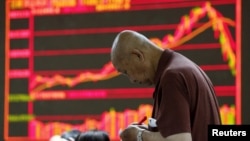Brazil, Russia, India, China, and South Africa -- the BRICS -- hope to move the world away from the U.S. dollar and Western-dominated financial institutions, which they say do not meet the needs of emerging economies.
But steep drops in recent weeks in the currencies of the five countries, which account for 40 percent of the world's population and about one-fifth of global economic output, underscore how difficult it would be for any of them to take the dollar's place.
In July, the Russian ruble fell to 60 to the dollar on sagging oil prices, canceling most of the partial rebound it had made since the end of last year, when it sank as low as 80 to the dollar due to low oil prices and Western financial sanctions over Moscow's interference in Ukraine. The ruble dropped to 64.4 per dollar on August 6, its weakest since February.
China's renminbi also fell against the dollar in July as China's stock market suddenly lost 30 percent of its value in a spectacular crash following a half-year of frantic, speculative growth.
For Russia, in addition to persistent geopolitical tensions, the ruble's volatility comes from being closely tied to commodity prices, a situation shared by the currencies of Brazil, India, and South Africa. China, one of the world's biggest commodity importers, has a much more diversified export sector but, as the stock-market crash showed, its gradually liberalizing economy still leaves plenty of room for surprises.
An Alternative To Free Markets?
Yet analysts say that an even bigger problem for all of the BRICS' currencies may be the way the countries' jittery, politically beholden central banks overmanage them in crises. That makes it difficult for investors to anticipate what will happen, further diminishing their attractiveness as a medium for global trade and investment.
"We have far from transparent monetary policies in Brazil or Russia and that raises the question of what are really the objectives of these central banks and under what conditions will they do what things, either in the currency market or in increasing interest rates," says Lars Christensen, an international economist and head of the Copenhagen-based Market and Money Advisory.
China has long dreamed of internationalizing its currency, and later this year the International Monetary Fund (IMF) is expected to consider whether to add the renminbi to its basket of reserve currencies that countries may use for depositing to, or borrowing from, the global lending institution. Today, there are only four such reserve currencies: the U.S. dollar, the euro, the Japanese yen, and the British pound.
But whether the renminbi, also known as the yuan, will be added to the list will depend much on Beijing's willingness to complete what so far has been only partial progress toward a free-floating exchange rate.
"The reason the renminbi has not been part of the IMF's so called Special Drawing Rights basket [of reserve currencies] has been that the renminbi has not been fully convertible and obviously we cannot talk of a currency as a reserve currency if you don't have completely free access to that currency," Christensen says.
To date, China's central bank has controlled the foreign exchange rate to keep it low against the dollar and give Chinese exports a price advantage over competitors. There are also capital restrictions on how much money can be transferred in and out of China.
That means a better way for China and the other BRICS to foster alternatives to the U.S. dollar might not be to build a rival system but instead to adopt the same free-market values that have made the dollar the world's most attractive currency for investors and traders.
But so far, the BRICS show little inclination as a bloc to move in that direction. Meeting last month in the Russian city of Ufa, the leaders of the five countries agreed to launch a long-planned New Development Bank to make infrastructure loans between members and a Foreign Exchange Currency Fund to provide each other emergency liquidity if their dollar reserves are stressed.
The new bank, with an initial capital of $50 billion, is in line with the group's goal of creating alternatives to Western-dominated financing, whose standards for lending and reporting reflect Western values of transparency and rule of law.
The new currency fund, which includes a pool of currency reserves worth $100 billion, is intended to help protect against devaluation of their currencies should global investors pull out of their economies in a crisis, as recently happened in Russia.









